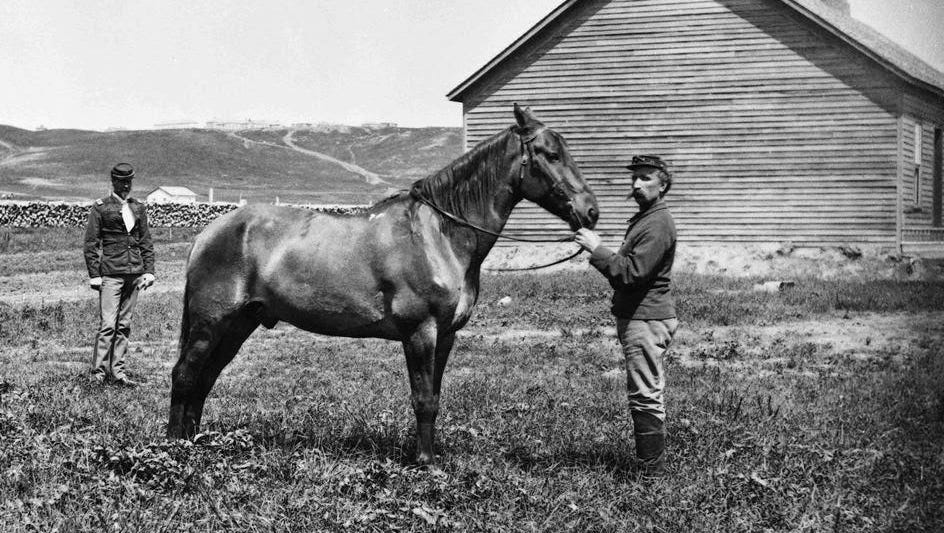
At Fort Riley, he became something of a pet, occasionally leading parades and indulging in a fondness for beer.Ĭomanche died of colic on November 7, 1891, believed to be 29 years old at the time. At Fort Leavenworth, Kansas, among a shipment of Mustangs just in from Indian Territory, the captain saw the horse he wanted and took the unusual step of buying. As one of the only horses to survive the infamous Battle of Little Bighorn in 1876, where the 7th Cavalry Regiment of the US Army suffered a terrible defeat. They rode horses, they hunted on horses, they lived. As an honor, he was made "Second Commanding Officer" of the 7th Cavalry. Whether by raid or trade, the Comanche became the most successful horse breeders among the Plains Indians. In June 1879, Comanche was brought to Fort Meade by the Seventh Regiment, where he was kept like a prince until 1887. His color is 'claybank' He would make a handsome carriage horse. On the Custer battlefield (actually Fort Abraham Lincoln) three of the balls were extracted from his body and the last one was not taken out until April '77…Comanche is not a great horse, physically talking he is of medium size, neatly put up, but quite noble looking. The life of the pedestrian tribe was revolutionized as they rapidly. Sometime during the late seventeenth century, the Comanches acquired horses, and that acquisition drastically altered their culture. He was sold for 90 to the Army and initially stationed at Fort Leavenworth.

Life Comanche was believed to have been captured as a wild horse and has been neutered and is formed in a Remontenstation in St.

There are four back of the foreshoulder, one through a hoof, and one on either hind leg. The Comanche language is derived from the Uto-Aztecan linguistic family and is virtually identical to the language of the Northern Shoshones. Comanche (horse) Comanche ( about 1862, November 7, 1891) was a cavalry horse that survived the Battle of Little Big Horn and became famous. His wounds were serious, but not necessarily fatal if properly looked after.He carries seven scars from as many bullet wounds. He was found by Sergeant DeLacey in a ravine where he had crawled, there to die and feed the Crows.

Here is the gist of what the reporter learned (Bismarck Tribune, May 10, 1878): Comanche was a veteran, 21 years old, and had been with the 7th Cavalry since its Organization in '66. His official keeper, the farrier John Rivers of Company I, Keogh's old troop, saved "Comanche's reputation" by answering more fully. Comanche was wounded many more times, but always exhibited the same toughness. He named the horse “Comanche” to honor his bravery. (1.) The horse known as ‘Comanche,’ being the only living representative of the bloody tragedy of the Little Bighorn, June 25th, 1876, his kind treatment and comfort shall be a matter of special pride and solicitude on the part of every member of the Seventh Cavalry to the end that his life be preserved to the utmost limit. In 1868, while the army was fighting the Comanche in Kansas, the horse was wounded in the hindquarters by an arrow, but continued to carry Keogh in the fight. Captain Myles Keogh of the 7th Cavalry liked the 15 -hand bay gelding and bought him for his personal mount, to be ridden only in battle.

However, it is a beautiful song, and I hereby dedicate this video to my awesome History teacher. His ancestry and date of birth were both uncertain. This is one of my favorite songs, though it is a little sad. Louis, Missouri and sent to Fort Leavenworth, Kansas. It can be found by clicking on the link below.Īssembly instructions can be found by clicking on the link below.Comanche was a mixed breed horse who survived General George Armstrong Custer's detachment of the United States 7th Cavalry at the Battle of the Little Bighorn. If you have questions about any of the weathervane options please check out our weathervane options help page. This weathervane is made from 24 GA 16 oz pure copper.Īdd 14” to the height for the copper balls and directionals. You are left with 12 inches of rod left over over below the large spacer ball to either go into one of our roof mounts or cupolas. The NSEW, and copper spacer balls take up 14 inches of the 3/4" rod.
Comanche horse upgrade#
Made from steel that has been powder coated black. You can upgrade this rod to stainless steel for harsh weather environmentsģ. The Weathervane is sold with the following.ġ. Weathervane mounting rod.


 0 kommentar(er)
0 kommentar(er)
